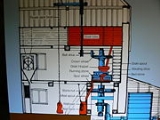
Mill machinery
Encyclopedia
This article covers the various major pieces of mill machinery to be found in windmills, watermills and horse mill
s. It does not cover machinery found in modern factories.
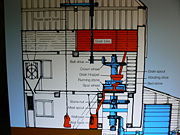
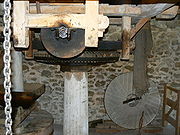

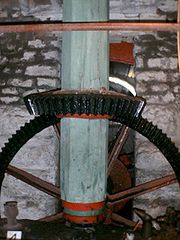
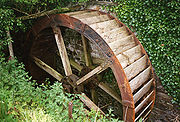 Axle
Axle
The axle carries the waterwheel. It can also carry the Pit Wheel at its opposite end.
Bedstone
The Bedstone is the bottom of a pair of millstones. It does not move. The upper stone is called the Runner Stone.
Crown Wheel
The Crown Wheel is a driving wheel located at the top of the Upright Shaft
Great Spur Wheel
The Great Spur Wheel is a large gear attached to the Upright Shaft. It drives one or more Stone Nuts in a corn mill. If mounted on a Layshaft it is called a Spur Wheel and only drives one Stone Nut
Hurst Frame
An internal framework supporting the gears and millstones. This isolation prevents damage to the building from the vibrations of the workings.
Layshaft
A Layshaft in a watermill is a horizontal shaft, carrying a Wallower and one or more Spur Wheels. The term can also refer to a minor shaft driving machinery by pulleys and belts.
Overdrift
Millstones driven from above are known as Overdrift stones.
Pit Wheel
The Pit Wheel is mounted on the opposite end of the axle to the waterwheel. It drives the Wallower on the Upright Shaft or Layshaft.
Rim Drive
Some waterwheels have a rack attached to the circumference, which drives the mill via a pinion mounted on a separate axle, which has a Pit Wheel at its opposite end. This is known as Rim Drive.
Runner Stone
The Runner Stone is the topmost of a pair of millstones. It is driven by the Stone Nut. The lower stone is called a Bedstone.
Stone Nut
A Stone Nut is a small gear driven by the Great Spur Wheel or Spur Wheel. It drives the Runner Stone. In most watermills, the stones are driven from below. These are called Underdrift stones. A few watermills drove the stones from above, known as Overdrift stones.
Turbine
In some watermills, a Turbine was used as a source of power instead of a Waterwheel. In many cases, the Turbine was installed when a watermill was modernised, although a few mills were built new with Turbines.
Underdrift
Millstones driven from beneath are known as Underdrift stones.
Upright Shaft
The Upright Shaft in the main driven shaft in a watermill. It carries the wallower, Great Spur Wheel and sometimes a Crown Wheel.
Wallower
The Wallower is a small gear at the base of the upright shaft in a watermill, it is driven by the Pit Wheel.
Waterwheel
A waterwheel is a source of power for a watermill. It is mounted on the axle and drives the mill by a Pit Wheel or Rim Drive. In some watermills, the Waterwheel was replaced by a Turbine.
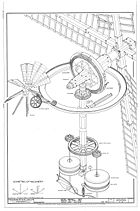
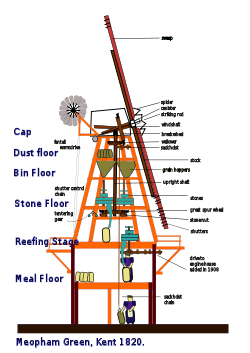
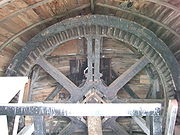
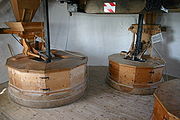

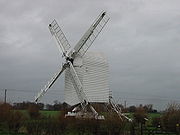

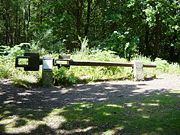 Bedstone
Bedstone
The Bedstone is the bottom of a pair of millstones. It does not move. The upper stone is called the Runner Stone.
Brake Wheel
The Brake Wheel is the main driving wheel in a Smock
or Tower mill
, and in some post mill
s. It is carried on the Windshaft and drives the Wallower on the Upright Shaft
Buck
The Buck is an East-Anglian term for the body of a post-mill.
Crown Tree
The Crown Tree is the central, single baulk of timber, usually oak, that rests on top of the post in a post mill. Attached to it are the side-girts and the rest of the frame of the buck.
Crown wheel
In a windmill, a Crown Wheel is an auxiliary gear on the Upright Shaft.
Fantail
A fantail
is a small windmill which is used to keep a windmill facing into the wind automatically.
Great Spur Wheel
The Great Spur Wheel is carried on the Upright Shaft It drives the Stone Nuts. Millstones driven by the Great Spur Wheel can be either Overdrift or Underdrift.
Head Wheel
The Head Wheel is carried on the Windshaft in a Post Mill and has a brake around its circumference. It drives a Stone Nut, Millstones driven by the Head Wheel are always Overdrift stones.
Middling
See Stock
Overdrift
Millstones driven from above are known as Overdrift stones.
Pintle
The pivot centering a post mill on top of the main post.
Runner Stone
The Runner Stone is the topmost of a pair of millstones. It is driven by the Stone Nut. The lower stone is called a Bedstone.
Sails
The Sails are the source of power in a windmill
. They are carried on the Windshaft. Most windmills had four sails, although some had five (Boston
), six (Waltham, Lincs
) or eight sails Heckington, Lincs
and there is one recorded twelve sailed windmill (Cottenham
, Cambs).
Common Sails have a lattice framework over which a sailcloth is spread. These were the earliest type of sails in northern European windmills.
Spring Sails, invented in 1772 by Andrew Meikle
, have shutters adjusted by a spring. Each sail is adjusted individually and, as with Common Sails the mill has to be stopped to enable an adjustment to be made.
Roller Reefing Sails, invented in 1789 by Stephen Hooper, use a canvas strip wound around a roller in the place of shutters. The mill does not have to be stopped in order to adjust the sails.
Patent Sails, invented in 1819 by William Cubitt
, combine the shutters of the Spring Sail with the automatic adjustment of the Roller Reefing Sail. Single Patents have shutters on the trailing side of the sail, Double Patents have shutters on both sides of the sail for its whole length.
Samson Head
An iron collar and plate bearing that fits over the pintle of a post-mill's post, that supports the weight of the crown tree, around which the buck of the mill is constructed. An example is visible at High Salvington windmill
.
Stock
The beam that passes through the canister of the windshaft, which the sails are bolted onto.
Stone Nut
The Stone Nut is a small gear driven by the Great Spur Wheel, Head Wheel, or Tail Wheel. It drives the Runner Stone either from above (Overdrift) or below (Underdrift).
Tail Wheel
The Tail Wheel is carried on the Windshaft in a Post Mill and drives a Stone Nut. Millstones driven by the Tail Wheel are always Overdrift stones.
Trestle
The Trestle
is the substructure of a Post Mill, usually enclosed in a protective structure called a roundhouse, which also serves as a storage facility. Post mills without a roundhouse are called Open Trestle Post Mills.
Underdrift
Millstones driven from beneath are known as Underdrift stones.
Upright Shaft
The Upright Shaft is the main vertical shaft found in Smock and Tower mills. It is also found in some Post mills. It carries the Wallower at its top end, and a Great Spur Wheel at the bottom end. The Great Spur Wheel drves two or more Stone nuts.
Wallower
The Wallower is a driven gear at the top of the Upright Shaft in Smock, Tower and some Post mills. It is driven by the Brake Wheel
Windshaft
The Windshaft carries the Sails and also the Brake Wheel (Smock and Tower mills, and in some Post mills) or the Head Wheel and Tail Wheel in a Post Mill. Windshafts can be wholly made of wood, or wood with a cast iron Poll End (where the Sails are mounted) or entirely of cast iron.
Horse mill
A horse mill is a mill that uses a horse as the power source. Any milling process can be powered in this way, but the most frequent use of animal power in horse mills was for grinding grain and pumping water. Other animals used for powering mills include dogs, donkeys and oxen. Engines powered by...
s. It does not cover machinery found in modern factories.
Watermill machinery





The axle carries the waterwheel. It can also carry the Pit Wheel at its opposite end.
Bedstone
The Bedstone is the bottom of a pair of millstones. It does not move. The upper stone is called the Runner Stone.
Crown Wheel
The Crown Wheel is a driving wheel located at the top of the Upright Shaft
Great Spur Wheel
The Great Spur Wheel is a large gear attached to the Upright Shaft. It drives one or more Stone Nuts in a corn mill. If mounted on a Layshaft it is called a Spur Wheel and only drives one Stone Nut
Hurst Frame
An internal framework supporting the gears and millstones. This isolation prevents damage to the building from the vibrations of the workings.
Layshaft
A Layshaft in a watermill is a horizontal shaft, carrying a Wallower and one or more Spur Wheels. The term can also refer to a minor shaft driving machinery by pulleys and belts.
Overdrift
Millstones driven from above are known as Overdrift stones.
Pit Wheel
The Pit Wheel is mounted on the opposite end of the axle to the waterwheel. It drives the Wallower on the Upright Shaft or Layshaft.
Rim Drive
Some waterwheels have a rack attached to the circumference, which drives the mill via a pinion mounted on a separate axle, which has a Pit Wheel at its opposite end. This is known as Rim Drive.
Runner Stone
The Runner Stone is the topmost of a pair of millstones. It is driven by the Stone Nut. The lower stone is called a Bedstone.
Stone Nut
A Stone Nut is a small gear driven by the Great Spur Wheel or Spur Wheel. It drives the Runner Stone. In most watermills, the stones are driven from below. These are called Underdrift stones. A few watermills drove the stones from above, known as Overdrift stones.
Turbine
In some watermills, a Turbine was used as a source of power instead of a Waterwheel. In many cases, the Turbine was installed when a watermill was modernised, although a few mills were built new with Turbines.
Underdrift
Millstones driven from beneath are known as Underdrift stones.
Upright Shaft
The Upright Shaft in the main driven shaft in a watermill. It carries the wallower, Great Spur Wheel and sometimes a Crown Wheel.
Wallower
The Wallower is a small gear at the base of the upright shaft in a watermill, it is driven by the Pit Wheel.
Waterwheel
A waterwheel is a source of power for a watermill. It is mounted on the axle and drives the mill by a Pit Wheel or Rim Drive. In some watermills, the Waterwheel was replaced by a Turbine.
Windmill machinery








The Bedstone is the bottom of a pair of millstones. It does not move. The upper stone is called the Runner Stone.
Brake Wheel
The Brake Wheel is the main driving wheel in a Smock
Smock mill
The smock mill is a type of windmill that consists of a sloping, horizontally weatherboarded tower, usually with six or eight sides. It is topped with a roof or cap that rotates to bring the sails into the wind...
or Tower mill
Tower mill
A tower mill is a type of windmill which consists of a brick or stone tower, on top of which sits a roof or cap which can be turned to bring the sails into the wind....
, and in some post mill
Post mill
The post mill is the earliest type of European windmill. The defining feature is that the whole body of the mill that houses the machinery is mounted on a single vertical post, around which it can be turned to bring the sails into the wind. The earliest post mills in England are thought to have...
s. It is carried on the Windshaft and drives the Wallower on the Upright Shaft
Buck
The Buck is an East-Anglian term for the body of a post-mill.
Crown Tree
The Crown Tree is the central, single baulk of timber, usually oak, that rests on top of the post in a post mill. Attached to it are the side-girts and the rest of the frame of the buck.
Crown wheel
In a windmill, a Crown Wheel is an auxiliary gear on the Upright Shaft.
Fantail
A fantail
Windmill fantail
A Fantail is a small windmill mounted at right angles to the sails, at the rear of the windmill, and which turns the cap automatically to bring it into the wind. The fantail was patented in 1745 by Edmund Lee, a blacksmith working at Brockmill Forge near Wigan, England, and perfected on mills...
is a small windmill which is used to keep a windmill facing into the wind automatically.
Great Spur Wheel
The Great Spur Wheel is carried on the Upright Shaft It drives the Stone Nuts. Millstones driven by the Great Spur Wheel can be either Overdrift or Underdrift.
Head Wheel
The Head Wheel is carried on the Windshaft in a Post Mill and has a brake around its circumference. It drives a Stone Nut, Millstones driven by the Head Wheel are always Overdrift stones.
Middling
See Stock
Overdrift
Millstones driven from above are known as Overdrift stones.
Pintle
The pivot centering a post mill on top of the main post.
Runner Stone
The Runner Stone is the topmost of a pair of millstones. It is driven by the Stone Nut. The lower stone is called a Bedstone.
Sails
The Sails are the source of power in a windmill
Windmill
A windmill is a machine which converts the energy of wind into rotational energy by means of vanes called sails or blades. Originally windmills were developed for milling grain for food production. In the course of history the windmill was adapted to many other industrial uses. An important...
. They are carried on the Windshaft. Most windmills had four sails, although some had five (Boston
Maud Foster Windmill
Maud Foster Windmill is a seven-storey, five sail windmill located by the Maud Foster Drain in Skirbeck, Boston, Lincolnshire, which she takes her name from...
), six (Waltham, Lincs
Waltham Windmill
Waltham Windmill is a six-sailed windmill located in the village of Waltham, five miles from Grimsby in North East Lincolnshire. It is renowned in the area for having all six sails still in full working capacity, being one of the very few windmills like this in the United Kingdom.-Construction:The...
) or eight sails Heckington, Lincs
Heckington
Heckington is a village and civil parish in the North Kesteven district of Lincolnshire, England. It lies between Sleaford and Swineshead Bridge, south of the A17 road. Heckington, with 1491 households, is one of the largest villages in Lincolnshire.-History:...
and there is one recorded twelve sailed windmill (Cottenham
Cottenham
Cottenham is a village in Cambridgeshire, England. It is close to The Fens. Before the fens were drained in the 19th century Cottenham was on the last contour before the waterlogged marshes, with Ely being the nearest dry land around to the north-east....
, Cambs).
Common Sails have a lattice framework over which a sailcloth is spread. These were the earliest type of sails in northern European windmills.
Spring Sails, invented in 1772 by Andrew Meikle
Andrew Meikle
Andrew Meikle was an early mechanical engineer credited with inventing the threshing machine, a device used to remove the outer husks from grains of wheat. This was regarded as one of the key developments of the British Agricultural Revolution in the late 18th century...
, have shutters adjusted by a spring. Each sail is adjusted individually and, as with Common Sails the mill has to be stopped to enable an adjustment to be made.
Roller Reefing Sails, invented in 1789 by Stephen Hooper, use a canvas strip wound around a roller in the place of shutters. The mill does not have to be stopped in order to adjust the sails.
Patent Sails, invented in 1819 by William Cubitt
William Cubitt
Sir William Cubitt was an eminent English civil engineer and millwright. Born in Norfolk, England, he was employed in many of the great engineering undertakings of his time. He invented a type of windmill sail and the prison treadwheel, and was employed as chief engineer, at Ransomes of Ipswich,...
, combine the shutters of the Spring Sail with the automatic adjustment of the Roller Reefing Sail. Single Patents have shutters on the trailing side of the sail, Double Patents have shutters on both sides of the sail for its whole length.
Samson Head
An iron collar and plate bearing that fits over the pintle of a post-mill's post, that supports the weight of the crown tree, around which the buck of the mill is constructed. An example is visible at High Salvington windmill
High Salvington windmill
Durrington or High Salvington Windmill is a Grade II listed post mill in High Salvington, Sussex that has been restored and is in full working order. The mill stands above sea level and is able to take advantage of incoming sea winds.-History:...
.
Stock
The beam that passes through the canister of the windshaft, which the sails are bolted onto.
Stone Nut
The Stone Nut is a small gear driven by the Great Spur Wheel, Head Wheel, or Tail Wheel. It drives the Runner Stone either from above (Overdrift) or below (Underdrift).
Tail Wheel
The Tail Wheel is carried on the Windshaft in a Post Mill and drives a Stone Nut. Millstones driven by the Tail Wheel are always Overdrift stones.
Trestle
The Trestle
Trestle (mill)
The Trestle of a Post mill is the arrangement of the Main post, crosstrees and quarterbars that form the substructure of this type of windmill. It may or may not be surrounded by a roundhouse...
is the substructure of a Post Mill, usually enclosed in a protective structure called a roundhouse, which also serves as a storage facility. Post mills without a roundhouse are called Open Trestle Post Mills.
Underdrift
Millstones driven from beneath are known as Underdrift stones.
Upright Shaft
The Upright Shaft is the main vertical shaft found in Smock and Tower mills. It is also found in some Post mills. It carries the Wallower at its top end, and a Great Spur Wheel at the bottom end. The Great Spur Wheel drves two or more Stone nuts.
Wallower
The Wallower is a driven gear at the top of the Upright Shaft in Smock, Tower and some Post mills. It is driven by the Brake Wheel
Windshaft
The Windshaft carries the Sails and also the Brake Wheel (Smock and Tower mills, and in some Post mills) or the Head Wheel and Tail Wheel in a Post Mill. Windshafts can be wholly made of wood, or wood with a cast iron Poll End (where the Sails are mounted) or entirely of cast iron.
See also
- "A Researcher's Guide to Local History Terminology" - Abecedary
- Glossary of mill terms

